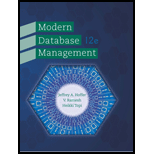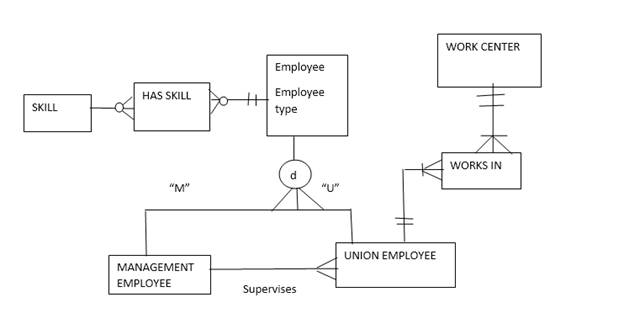
Concept explainers
Define each of the following terms:
- supertype
- subtype
- specialization
- entity cluster
- completeness constraint
- enhanced entity-relationship (EER) model
- supertype/subtype hierarchy
- total specialization rule
- generalization
- disjoint rule
- overlap rule
- partial specialization rule
- universal data model
(a)
Definition of supertype
Explanation of Solution
Supertype is an entity that has relationship with one or more subtypes and contains some common subtype attributes. For example, when we are designing a data model for the employee, then we can have employee as a supertype, and its attributes like salary employee and contracted employee are taken as subtype.
(b)
Subtype
Explanation of Solution
Subtypes are the subgroups of the supertype entities. Each subtype consists of some unique attributes and is different from each other. For example, when we are creating a data model for the employee details, here we have one supertype entity employee with many subtype entities like part time employee, full time employee, and salaried employee, etc.
(c)
Specialization
Explanation of Solution
It is an opposite approach of the generalization. It is used to break down the higher level of the entity into the subgroups of lower level entity. Specialization is used to identify the subset entity that is sharing some common and distinguished characters.
Example:

(d)
Entity cluster
Explanation of Solution
Entity cluster is a useful way to represent the data model for large and complex organization. Entity cluster is a collection of various entities that are combined to form one common entity. An entity can be considered as virtual in the entity cluster. These entities are developed with the purpose of the reliability and simplification of data. EER diagram of an entity cluster is given below:
(e)
Completeness constraints
Explanation of Solution
Completeness constraints are used to check that the supertype entity must have an occurrence of the subtype entity. It is basically used to check the common attributes among the supertype and the subtype. There are two types of completeness constraints:
- Partial specialization: In Partial specialization, it is not necessary that all the subtype and the supertype entities are related to each other totally. There might be some cases where a partial relationship between the entities is possible. It can be represented by using a single line. Consider the below given diagram.
- Total specialization: In total specialization, it is necessary that all the subtype and the supertype entities are related to each other totally. It can be represented by using a single line. Consider the below given diagram.

Here, a person has a license. Suppose we have 5 people among which only 2 have license and rest do not. Then, it is a case of partial specialization. Here, it not necessary that all the people have license, there might be some persons who do not possess a license.

Here, the license should always belong to a particular person, i.e., there is no license without a person. This is a case of total specialization.
(f)
Enhanced entity-relationship (EER) model.
Explanation of Solution
Enhanced entity-relationship (EER) model is the enhanced model form of entity relational data model. It is a higher-level conceptual model of the computer science that is used to develop the advance databases, complex software designs, and geographic information systems (GIS), etc. Enhanced entity-relationship (EER) model reflects the data properties and constraints more precisely. It also consists of all the concepts of the entity relation diagram, specialization, and generalization.
(g)
Supertype/subtype hierarchy.
Explanation of Solution
Supertype/subtype hierarchy is the structure in which the supertype and the subtype entities are leveled according to their order. This organization of data make the data more modular and easier to understand and use.
(h)
Total specialization rule
Explanation of Solution
Total specialization rule is used to ensure that every entity of the subtype belongs to the supertype entity, i.e., there must be no entity of superclass which is not belongs to the subtype.
(i)
Generalization.
Explanation of Solution
Generalization is a process of extracting common features from multiple entities source in order to create a new entity. it helps in reducing the size of schema. Generalization provide one entity from multiple entity. Bottom − up designing strategies are used in the Generalization.
In Generalization entity all the all higher-level entities have the lower level entity. There is no higher entity without the lower level entity.
(j)
Disjoint rules
Explanation of Solution
The disjoint rule specifies that the entity object of supertype can only be the member of any of the subtype. For example, let’s consider animal as a supertype. Then it can have subtype entities like dog, cat, etc., In disjoint rule, the supertype class animal can be associated with the dog or cat at one time. i.e., the animal can be either dog or cat.
(k)
Overlap rule
Explanation of Solution
In the overlap rule, the supertype can be associated with more than one subtype entities. For example, consider a supertype entity student that can be associated with many subjects like math, English, Hindi and many more.
(l)
Partial specialization rules
Explanation of Solution
Partial specialization rules allow that the entity of supertype must not always need to belong to the subtype entity. Consider a supertype entity vehicle having subtypes entities car and truck. Here motorcycle is also subtype of vehicles, but it is not specified as subtype in the data model. Thus, if a vehicle is a car, then it must appear in the object of car and if the vehicle is a truck, it must appear in the object of truck. But if the vehicle is a motorcycle, then it cannot appear in any of the subtypes.
(m)
Universal data model
Explanation of Solution
Universal data model can be used as a starting point for the data modeling project. It is also known as a data model pattern. Advantages of using the Universal data model:
- Project takes less time and efforts to develop as all the essential components and structures are already designed and need only to be customized according to the requirement.
- Data models of the existing database are easier to read by the data modeler and other data management experts, as it is based on the common components seen in the other situations.
Want to see more full solutions like this?
Chapter 3 Solutions
Modern Database Management (12th Edition)
Additional Engineering Textbook Solutions
Starting Out with Java: From Control Structures through Objects (7th Edition) (What's New in Computer Science)
C Programming Language
Concepts Of Programming Languages
Absolute Java (6th Edition)
Introduction to Java Programming and Data Structures, Comprehensive Version (11th Edition)
- Give an example of each of the following: a. a supertype/subtype relationship where the disjoint rule applies b. a supertype/ subtype relationship where the overlap rule appliesarrow_forwardExplain how weak entity representation differs from strong entity representation.arrow_forwardCode for Mapping relationship with Entity Framework Code First: One-to-one and variationsarrow_forward
- How to convert a weak entity set into a strong entity set?arrow_forwardDiscuss the categorization of traceability relations; elicit a short example that describes the classification context; and, if required, construct a diagram.arrow_forwardMap the EER diagram to a relational schema and transform the relation into 3NFarrow_forward
 Principles of Information Systems (MindTap Course...Computer ScienceISBN:9781285867168Author:Ralph Stair, George ReynoldsPublisher:Cengage Learning
Principles of Information Systems (MindTap Course...Computer ScienceISBN:9781285867168Author:Ralph Stair, George ReynoldsPublisher:Cengage Learning Fundamentals of Information SystemsComputer ScienceISBN:9781305082168Author:Ralph Stair, George ReynoldsPublisher:Cengage Learning
Fundamentals of Information SystemsComputer ScienceISBN:9781305082168Author:Ralph Stair, George ReynoldsPublisher:Cengage Learning Principles of Information Systems (MindTap Course...Computer ScienceISBN:9781305971776Author:Ralph Stair, George ReynoldsPublisher:Cengage Learning
Principles of Information Systems (MindTap Course...Computer ScienceISBN:9781305971776Author:Ralph Stair, George ReynoldsPublisher:Cengage Learning


